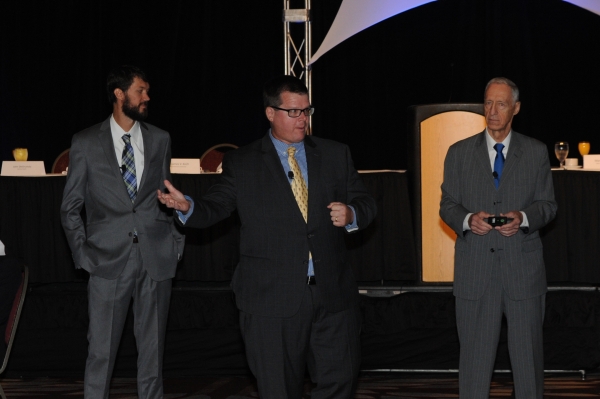We've Seen This Movie Before: ODU's State of the Region Report Shows Hampton Roads is Wrestling with Recession Recovery
October 04, 2016
 ODU professors (from left) Timothy Komarek, Robert McNab and James V. Koch respond to audience inquiries at the 17th annual State of the Region report.
ODU professors (from left) Timothy Komarek, Robert McNab and James V. Koch respond to audience inquiries at the 17th annual State of the Region report.
Putting a slide of old movies on the screen at the Norfolk Marriott Waterside, Old Dominion University President Emeritus James V. Koch started the annual State of the Region presentation by asking the audience a rhetorical question.
"I feel like asking, 'Have you seen this movie before?' Unfortunately, I think the answer is yes," Koch, the University's Board of Visitors professor of economics, told the crowd of more than 600 business and community leaders. "Looming above everything is the relatively slow growth of our regional economy, which I know we've been saying since the Great Recession."
The annual State of the Region report, produced every year since 2000, is widely respected as an impartial analysis of issues facing Hampton Roads.
This year's report indicated that Hampton Roads continues to wrestle with economic challenges brought eight years ago by the global economic slowdown, and in the last five years by a cuts to federal Department of Defense spending.
The region actually experienced a larger than normal 3.7 percent growth rate in 2015, but Koch said he expects that estimate to be revised downward, and this year's expected growth rate is an abysmal 1.2 percent. The region's slow recovery from the worldwide economic slowdown of 2007-09 hangs over Hampton Roads, but its economic activity is still substantial, Koch said.
"If it were its own country, Hampton Roads would have the 60th-largest economy in the world by GDP," he said. "This is a big region, we have lots to brag about. Jobs are where the challenge lies."
Hampton Roads is still 1.68 percent below the pre-recession employment peak, while the country as a whole has surpassed pre-recession employment levels by nearly four percent.
Bob McNab, assistant director of Old Dominion's Center for Economic Analysis and Policy, which produces the State of the Region, presented further economic details from this year's report.
McNab illustrated how federal spending has been almost flat for a decade, and that has affected the entire economy, including the other two "pillars:" the Port of Virginia and tourism.
Congress has negotiated short-term increases in the discretionary spending caps mandated by sequestration repeatedly over the past four years. "This has imposed an informal two-year business cycle on the Department of Defense. It makes for increased uncertainty," McNab said.
In addition to economic issues, the annual State of the Region report spotlights several other topics every year. Timothy Komarek, assistant professor of economics, told the State of the Region audience how rush-hour commute times have increased in the region over 25 years.
"Congestion is a 10-letter word, but I know for many people in Hampton Roads, it's a four-letter word," Komarek said. He also offered a sobering fact for commuters excited about infrastructure expansions such as the second Midtown Tunnel tube.
Komarek said the economic principle of induced demand almost always follows additional traffic infrastructure being constructed. Extra room on roads, tunnels and bridges only encourages more traffic, he said.
"What it means is that new construction won't help alleviate congestion, Komarek continued. "In six to 12 months after a new project is complete, traffic is right back to the level it was before it was constructed."
Every year, the State of the Region includes chapters focusing on various issues affecting Hampton Roads. The report authors referenced an Oxford University study that concluded nearly half of jobs worldwide are potentially at risk of being eliminated because of automation.
Koch said automation has helped a manufacturing workforce with 15 percent fewer jobs become more than 20 percent more productive in a little more than a decade.
"In an overall sense, it's a good thing. It's just a question of what sectors where the jobs will disappear. The key is how repetitive a job is," Koch said.
This year's report also has a chapter about the lesbian, gay, bisexual, transgender and queer community in Hampton Roads.
Census data isn't available about sexual orientation in the United States because the question is not asked. But extrapolating from Canadian census data (where the question is asked) and other sources, the State of the Region report estimates the LBGTQ community to be 4.4 percent of the region's population, earning total wages of $2.01 billion.
Other chapters in this year's State of the Region report explored:
Prisons and Prisoners: The Virginia Way and Alternatives: Virginia incarcerates large numbers of individuals which is expensive. Economic analysis suggests that the commonwealth would save money if it did not imprison so many, redefined what constitutes a felony and gave more attention to preparing prisoners for reentry into society.
The Rise of Single Households: Why It Matters: Almost one-third of all households in Hampton Roads are "non-family," meaning they are not headed by married individuals. More than 40 percent of all births now occur out of wedlock, and the number of elderly single people has skyrocketed. Public and private programs and policies have not kept pace with these developments and are in need of revision.
After the Oct. 7 State of the Region presentation on the Peninsula, at the Hampton Roads Convention Center, the full report will be posted on the State of the Region website.

